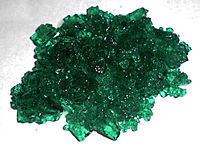Formula Ni(NO3)2 Melting point 56.7 °C Density 2.05 g/cm³ | Molar mass 182.703 g/mol Boiling point 136.7 °C | |
 | ||
Related compounds Appearance emerald green hygroscopic solid | ||
Nickel nitrate is the inorganic compound Ni(NO3)2 or any hydrate thereof. The anhydrous form is not commonly encountered, thus "nickel nitrate" usually refers to nickel(II) nitrate hexahydrate. The formula for this species is written in two ways. Ni(NO3)2.6H2O and, more descriptively [Ni(H2O)6](NO3)2. The latter formula indicates that the nickel(II) center is surrounded by six water molecules in this hydrated salt. In the hexahydrate, the nitrate anions are not bonded to nickel. Also known are three other hydrates: Ni(NO3)2.9H2O, Ni(NO3)2.4H2O, and Ni(NO3)2.2H2O. Anhydrous Ni(NO3)2 is also known.
It is prepared by the reaction of nickel oxide with nitric acid:
NiO + 2 HNO3 + 5 H2O → Ni(NO3)2.6H2OThe anhydrous nickel nitrate is typically not prepared by the heating the hydrates. Rather is generated by reaction of hydrates with dinitrogen pentoxide or of nickel carbonyl with dinitrogen tetroxide:
Ni(CO)4 + 2 N2O4 → Ni(NO3)2 + 2 NO + 4 COThe hydrated nitrate is often used as a precursor to supported nickel catalysts.
Safety
Like other nitrates, nickel nitrate is oxidizing. It is also irritating to the eyes, skin and, upon inhalation of the dust, respiratory tract. It may cause skin allergy. Nickel nitrate is a carcinogen, along with most other nickel compounds. The nickel ion is also toxic to aquatic organisms.
